
Executive Guide: Transforming B2B Software Development with AI
October 20, 2025 / Bryan ReynoldsThe AI Co-Creator: A B2B Executive's Guide to Building Software in the Age of Artificial Intelligence
Introduction: Beyond Automation—Your New Competitive Edge
Artificial Intelligence is no longer just an incremental tool for optimizing business processes; it’s now a foundational, general-purpose technology with an impact that industry analysts compare to the steam engine, electricity, and the internet. For B2B executives, this is not some distant forecast, but a present-day reality fundamentally reshaping how software is conceived, built, and delivered. The question is no longer if an organization should adopt AI in its development lifecycle, but how it can be done strategically to build a lasting competitive advantage.
The urgency of this transformation is underscored by staggering market projections and widespread adoption. The global AI market is forecast to surge from approximately $294 billion in 2025 to over $1.8 trillion by 2030, driven by a compound annual growth rate (CAGR) of nearly 36%. This is not a trend confined to tech giants; 73% of technology leaders across industries have identified the expansion of AI use as their top priority for 2025, and an overwhelming nine out of ten organizations believe AI is essential for maintaining a competitive edge. Inaction is now a significant strategic risk.
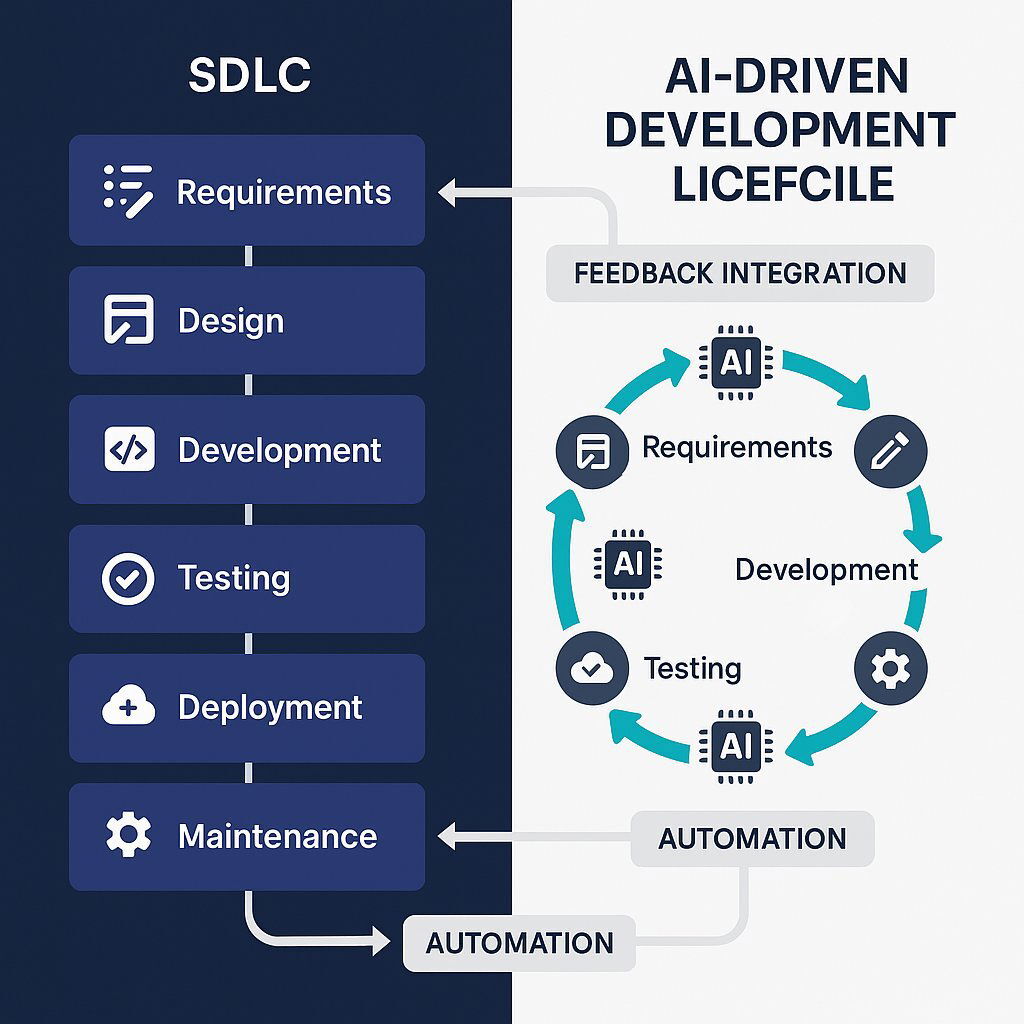
At Baytech Consulting, we see this technological shift not as a race to replace human talent, but as an opportunity to redefine its potential. The true value of AI in software development lies in its ability to serve as a central collaborator—a co-creator that augments the capabilities of development teams. By automating routine tasks and providing data-driven foresight, AI liberates developers from cognitive-draining work, allowing them to evolve from “code producers to system thinkers.” This human-centric approach, which places AI as a partner to human innovation, is the key to unlocking unprecedented gains in speed, quality, and creative progress.
This report serves as a definitive guide for B2B executives navigating this evolving landscape. We move beyond the hype to provide a clear-eyed, data-driven analysis of how to strategically integrate AI into the software development lifecycle. You’ll explore a reimagined development blueprint powered by AI, discover the complex realities of measuring return on investment, survey the arsenal of AI tools from copilots to autonomous agents, and confront the critical implementation risks up close. Finally, the Baytech Playbook delivers a strategic framework for leading successful, enterprise-wide AI adoption—building not just smarter software but a more intelligent and resilient organization.
Section 1: The New Development Blueprint: Reimagining the SDLC with AI
Integrating Artificial Intelligence into software development is not about simply accelerating existing processes—it’s about fundamentally reinventing the entire methodology. The traditional, often linear Software Development Lifecycle (SDLC) is giving way to a more dynamic, intelligent, and collaborative model. This new paradigm, known as the AI-Driven Development Lifecycle (AI-DLC) , bakes AI capabilities into the very fabric of software creation. AI is no longer a peripheral assistant; it has stepped into the role of a core collaborator.
This shift transforms the SDLC from a sequence of discrete, often human-gated stages into a continuous, AI-infused feedback loop. Whereas the traditional model channels information sequentially—from requirements to design to code—the AI-DLC creates a unifying thread connecting every phase. For example, AI can analyze user feedback during the maintenance phase and directly generate new, data-validated user stories for the requirements phase. AI-generated test cases can be derived straight from AI-parsed requirements, guaranteeing alignment. All this interconnectedness collapses cycle times between user feedback and new features, letting the system learn and get better with each iteration. This is a decisive edge over teams still working in rigid, linear silos.
Phase 1: Requirements & Planning - From Guesswork to Data-Driven Precision
Traditional Challenge: The first phase of software development has long depended on manual interviews and inferred customer needs—leaving plenty of room for subjectivity and missed marks.
AI-Powered Transformation: AI shifts the game by mining massive, unstructured data sources for objective insights. Natural Language Processing (NLP) models can systematically analyze thousands of product reviews, support chats, and app usage logs to uncover real pain points and unmet needs. Product managers now have the power to build what users really want—not just what they think they want. Large Language Models (LLMs) can even transform broad business goals into well-formed user stories, flagging inconsistencies or missing logic in the process. By assessing past project data, AI tools can also predict risks and improve resource forecasting, so planning starts on a solid foundation.
Tools in Action: Project management platforms such as Jira are now AI-powered through plugins like BigPicture or Elements.ai—delivering advanced task automation, risk prediction, and scheduling optimization for unmatched efficiency.
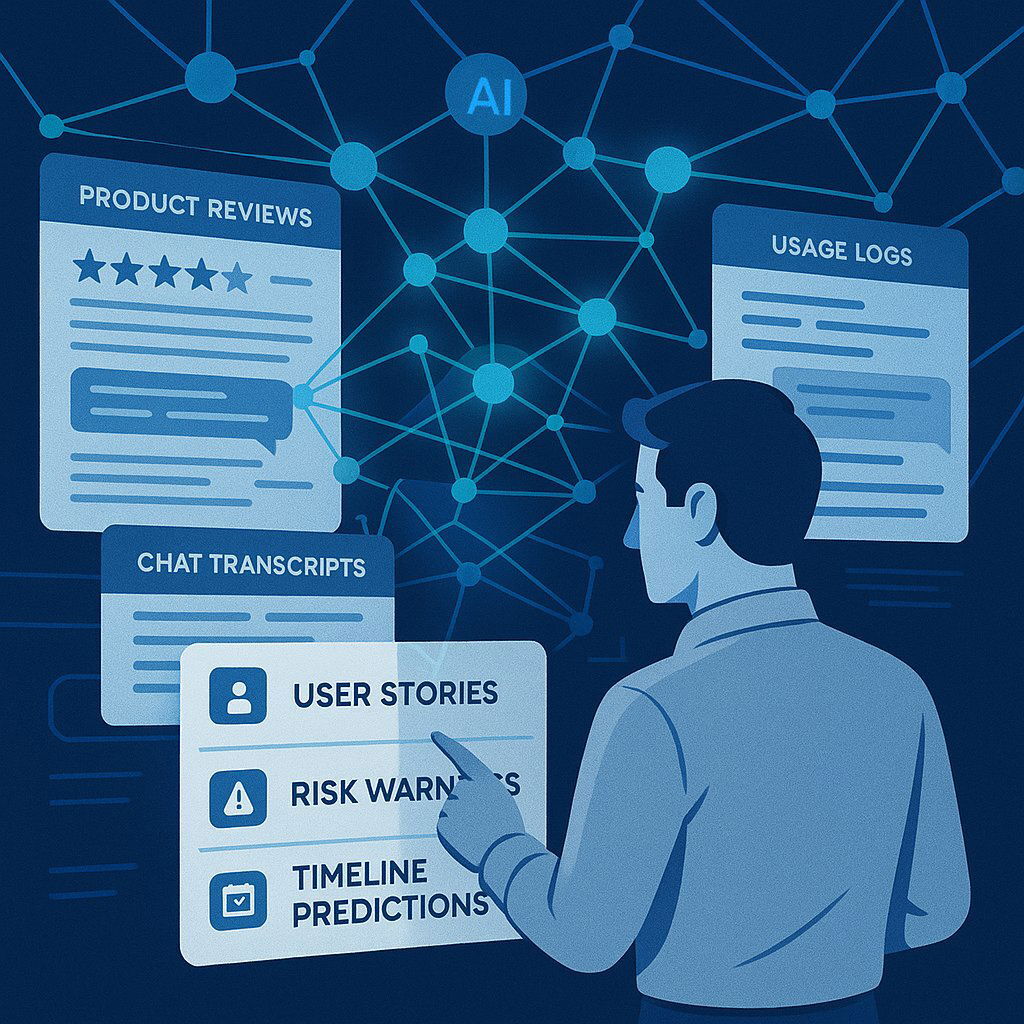
Phase 2: Design & Architecture - Architecting with Foresight, Not Hindsight
Traditional Challenge: Arguably the most important decisions in software—architecture—are too often intuition-driven. Real-world validation (like load, latency, or failover) doesn’t happen until production, when fixes become pricey.
AI-Powered Transformation: AI equips teams to architect with data-backed foresight. Advanced tools simulate how a planned system will cope under stress—spotting bottlenecks and vulnerabilities before a single line of code is written. AI can even suggest design patterns, flag anti-patterns, or automate creation of complex diagrams like flowcharts or wireframes, grounding every decision in real-world scenarios.
Tools in Action: Design platforms like Figma plug into AI solutions—such as Uizard or Galileo AI—to generate interactive prototypes from text. Diagramming tools like Lucidchart use AI to optimize workflows and automate architecture visuals.
Phase 3: Development & Construction - The Rise of the Human-AI Programming Pair
Traditional Challenge: Developers frequently spend too much time on repetitive, mind-numbing work: boilerplate code, standard error handling, component scaffolding, and mountains of documentation. All that context switching eats into the time—and creative energy—needed for tough business problems.
AI-Powered Transformation: Enter AI coding assistants—the virtual programming partners that can transform the developer’s day-to-day. They provide real-time, context-aware code suggestions; generate whole functions or classes from natural language; and continuously recommend ways to refactor and optimize code quality. With this, the developer's role moves from “code producer” to “system thinker,” guiding AI to build sound solutions and freeing bandwidth for higher-level strategy.
Tools in Action: The market is alive with advanced AI coding assistants—GitHub Copilot, Amazon CodeWhisperer, Tabnine, and models like Claude, which is especially popular for writing clean, documented code.
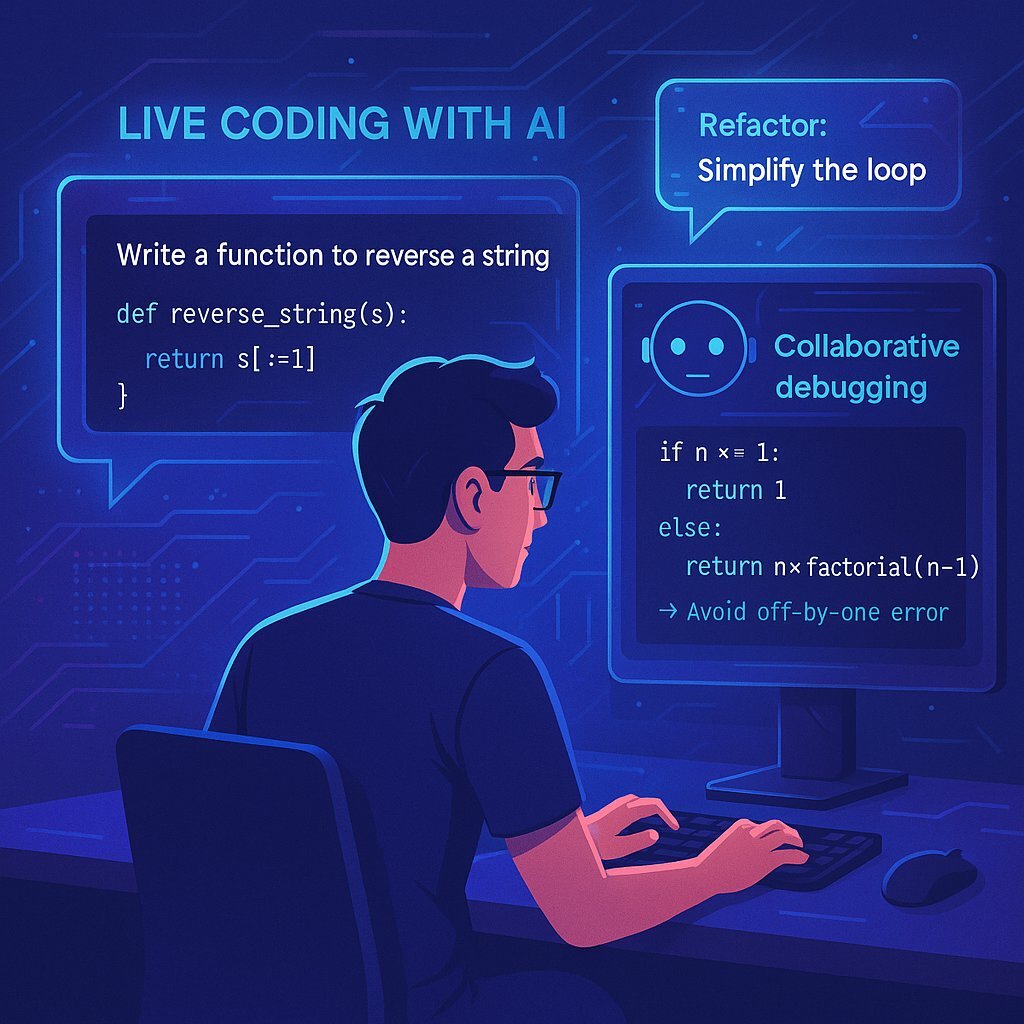
Phase 4: Testing & Quality Assurance - Intelligent Coverage, Not Brute Force
Traditional Challenge: Manual testing is slow, costly, and often misses the kind of edge cases that cause real trouble in production. Automated scripts help, but those scripts often break the moment a UI changes—making them a headache to manage.
AI-Powered Transformation: AI turns QA into a smart, adaptive, and risk-aligned process. Generative AI analyzes requirements or code and generates a broad suite of test cases—surfacing edge cases a human might neglect. By examining recent code tweaks, predictive models can focus attention on the riskiest spots. Self-healing capabilities mean AI-based testing tools monitor for UI changes and automatically update scripts, slashing maintenance costs.
Tools in Action: Self-healing automated tests from platforms like Testim adapt to app changes, while Applitools brings advanced AI-driven visual testing to instantly spot UI flaws.
Phase 5: Deployment & Operations - Continuous Intelligence for Continuous Delivery
Traditional Challenge: Even with solid CI/CD pipelines, pushing code to production always brings on nerves. Environment mismatches trigger the dreaded “it works on my machine” scenario, sometimes leaving teams scrambling after a release.
AI-Powered Transformation: With predictive intelligence, AI-enhanced CI/CD pipelines can look at past deployment data, anticipate risk, and propose the best strategy—like canary or blue/green releases. AI can even spot a failing update and trigger auto-rollbacks to last good configurations. In the realm of Infrastructure as Code (IaC), AI predicts resource needs and flags configuration drift—making it easier to stay synchronized from developer laptops to production servers.
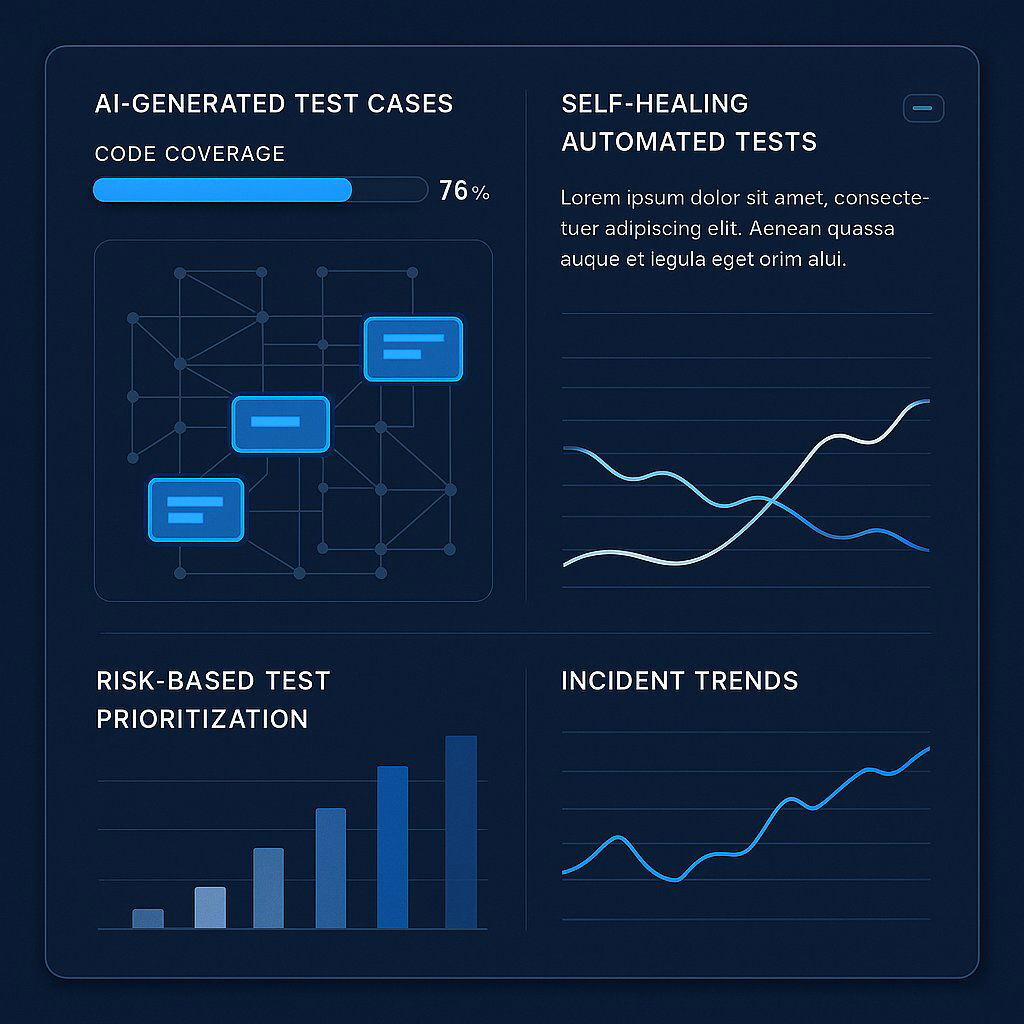
Tools in Action: Azure DevOps now offers tight AI integration (for instance with Copilot), while platforms such as Jenkins X or Kubert Lite use AI to predict pipeline hiccups before they snowball.
Phase 6: Maintenance & Support - Proactive and Predictive Upkeep
Traditional Challenge: Application maintenance is usually reactive—teams rush to fix problems only after users report them, leading to frustration and sometimes business disruption.
AI-Powered Transformation: AI moves maintenance into the proactive and predictive realm. By scouring performance metrics and system logs, AI spots trouble early, recommends targeted fixes, and helps avoid costly outages. On the user side, AI chatbots and virtual assistants field the routine requests, assemble self-serve documentation on the fly, and escalate tougher cases to the right professionals—making every response faster and ensuring experts spend time where it matters most.
Tools in Action: Observability platforms like Datadog use AI to visualize performance deep-dives, while incident platforms like PagerDuty rely on AI for smarter alerting and automated incident triage.
| SDLC Phase | Traditional Challenge | AI-Powered Transformation | Key Capabilities | Example Tools |
|---|---|---|---|---|
| Requirements & Planning | Subjective, manual, and prone to gaps in understanding user needs. | Data-driven and predictive, turning user behavior into actionable intelligence. | NLP for user feedback analysis, automated user story generation, risk prediction. | Jira with AI Plugins, Microsoft Project AI |
| Design & Architecture | Based on intuition and past experience; difficult to validate under stress. | Simulated and validated, providing data-backed foresight before development. | Architecture simulation, anti-pattern detection, automated prototyping from text. | Figma with Galileo AI, Lucidchart |
| Development | Time-consuming, repetitive coding tasks reduce focus on high-value problems. | Collaborative and augmented, with AI as a virtual pair programmer. | Real-time code completion, function generation, continuous code optimization. | GitHub Copilot, Amazon CodeWhisperer, Claude |
| Testing & QA | Slow, incomplete manual testing; brittle automated scripts require high maintenance. | Intelligent and adaptive, focusing on risk and automatically healing broken tests. | Automated test case generation, predictive test prioritization, self-healing test suites. | Testim, Applitools |
| Deployment & Operations | Risky, manual deployments; environment inconsistencies cause post-release failures. | Predictive and automated, enabling continuous delivery with continuous intelligence. | Intelligent release strategy selection, automated rollbacks, environment synchronization. | Azure DevOps, Kubert Lite, Jenkins X |
| Maintenance & Support | Reactive response to user-reported issues and system failures. | Proactive and predictive, identifying and resolving issues before they impact users. | Predictive bottleneck analysis, AI-powered chatbots, intelligent alert prioritization. | Datadog, PagerDuty |
Section 2: The Bottom Line: Deconstructing the ROI of AI in Software Development
For any B2B executive, the decision to invest in a transformative technology like AI hinges on clear, compelling return on investment. While the market floods us with wild claims of hyper-productivity, leaders need a nuanced look at the data and a real grasp of all the costs and benefits. The true business case for AI in software development isn’t about simple efficiency metrics alone—it’s about building up your organization's capabilities in a strategic way.
The Promise of Hyper-Productivity
The headline argument for AI typically leans on eye-catching productivity metrics that look great on paper. The most widely circulated evidence comes from a GitHub Copilot study—developers with Copilot finished a programming task 55% faster than those without. That sort of speedup has huge implications for time-to-market, making it a real differentiator. Beyond just speed, Copilot users also described higher job satisfaction and enjoyment, shining a light on AI’s power to boost developer happiness—no small feat in today’s competitive talent market.
Introducing the Productivity Paradox: A Necessary Dose of Reality
These numbers are tempting, but a closer look at more recent research reveals reality is more complicated—let’s call it the “Productivity Paradox.” Some studies show big gains; others, not so much. Executives who expect every AI use case to boost productivity by 55% are likely to be disappointed.
A landmark randomized controlled trial from METR.org in early 2025 put this in perspective: when seasoned open-source developers tackled complex bug fixes and new features, using high-end AI models made them 19% slower on average. A large-scale Stanford study led by Yegor Denisov-Blanch, based on productivity data from close to 100,000 developers, found a more moderate average lift—about 20%. Hurtfully, some teams even saw a decrease in productivity after adding AI to their work.
Variability in these outcomes usually comes down to the context. Stanford’s research underscores that AI works best for routine, well-defined tasks and can bog down expert developers when tackling complex work in mature codebases. “Rework” is the villain here: AI generates volumes of code quickly, but it’s sometimes subtly flawed or mismatched, requiring plenty of senior developer time for rework—obliterating initial time savings. Across the industry, 66% of developers point to “almost right, but not quite” AI solutions as their most frustrating pain point.
What does all this mean for leaders? The biggest return from AI comes not from “doing the same things faster,” but from freeing your best people to focus on strategic and innovative work. Let AI handle the mundane so senior engineers can create new products that win customers and separate your offering from the crowd. Anchor your business case not just in efficiency (“faster for less”) but also in opportunity (“unlock capacity for innovation and game-changing products”).
| Study / Report | Key Finding (Metric) | Context / Task Type | Developer Experience Level | Executive Takeaway |
|---|---|---|---|---|
| GitHub Copilot Study (2022) | Developers were 55% faster at completing a specific coding task. | Writing an HTTP server in JavaScript from scratch. A well-defined, greenfield task. | Mix of professional developers. | AI provides a massive speed boost for routine, boilerplate, and well-defined coding tasks. Excellent for accelerating prototyping and onboarding. |
| METR.org RCT (2025) | Developers were 19% slower when using AI tools. | Real-world bug fixes and feature requests in large, high-quality open-source repositories. | Experienced open-source developers. | For complex, nuanced tasks in mature codebases with high quality standards, current AI can introduce friction and slow down expert developers. |
| Stanford / Denisov-Blanch Study (2025) | Average productivity boost of ~20% , but with high variance and some teams seeing a decrease. | Real-world development activity across hundreds of companies and diverse codebases. | All levels, from junior to senior. | AI provides a net positive impact on average, but its effectiveness is highly contextual. Do not apply a one-size-fits-all expectation; deploy AI strategically. |
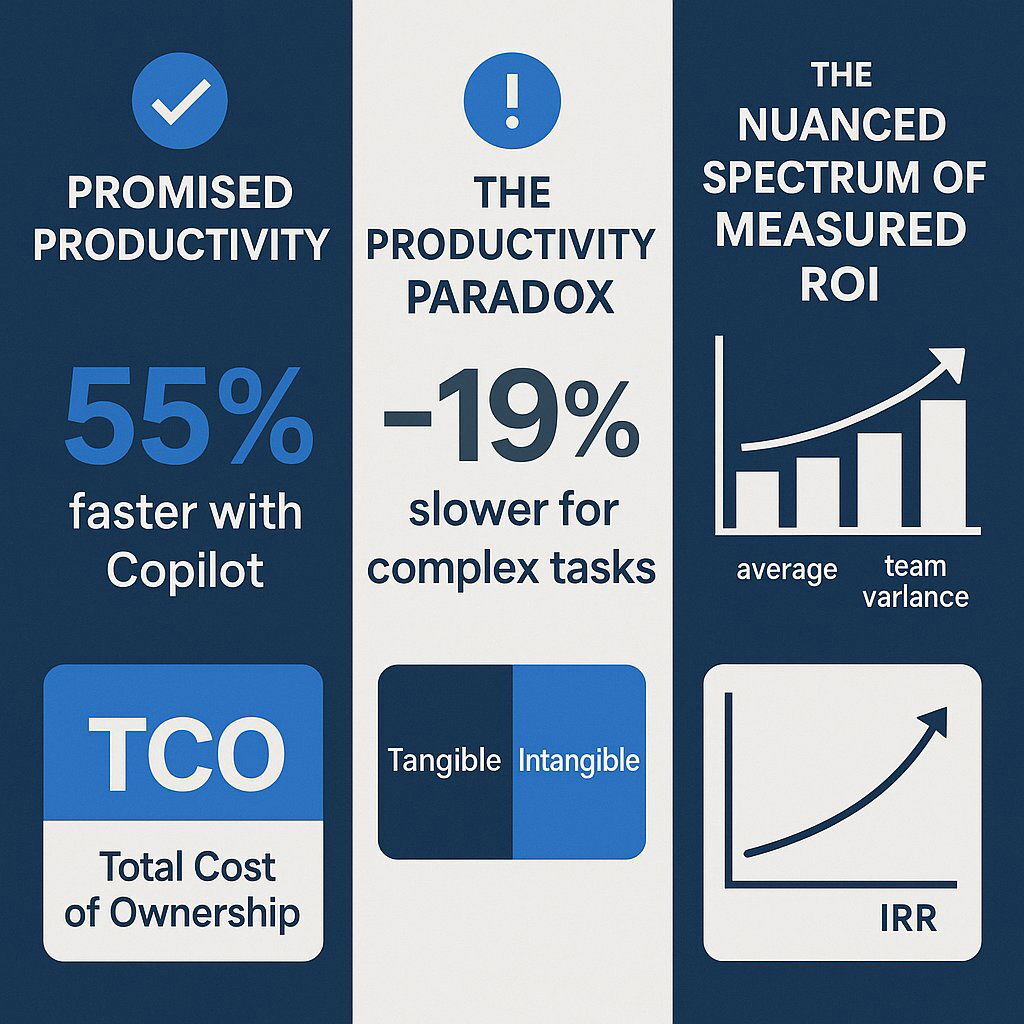
A CFO's Guide to AI ROI: The Baytech Consulting Framework
To make your case for AI improvement rock-solid, it’s important to move beyond generic productivity stats and use a disciplined, financial framework—one built around the total cost of ownership, tangible and intangible benefits, and measuring real business impact.
- High Initial Investment: Factor in not just software, but any specialized AI hardware, cloud costs, and professional services. Some simple projects may begin at $50,000, while comprehensive enterprise rollouts could cross $500,000.
- Data Preparation & Integration: Don’t forget the time and cost to clean, structure, and migrate your data—this is a key pillar of AI readiness and often makes or breaks success.
- Ongoing Maintenance & Retraining: Models degrade, so schedule and budget for periodic retraining (often every 12-18 months).
- Talent & Upskilling: Training your teams to use AI tools safely and skillfully is essential—factor this into TCO.
For quantifiable benefits:
- Cost Savings: Count up the labor saved, bugs caught earlier, and resources better used—AI can automate work such as code generation or test writing, shaving hours off developer routine.
- Revenue Enhancement: Faster delivery and improved product-market fit open new revenue channels. For practical examples and benchmarks, check out our guide on how custom solutions drive long-term value.
Don’t underestimate intangible outcomes:
- Improved Software Quality & Security: By standardizing architecture and code, AI can boost reliability and keep vulnerabilities in check.
- Enhanced Developer Experience: Automating tedious work unleashes creativity and can boost retention.
- Accelerated Innovation: Free your top thinkers to do more impactful, creative work.
Pull all this together using metrics like Net Present Value (NPV) and Internal Rate of Return (IRR) for investments—translating technical wins into the language your board or finance partner can appreciate.
Section 3: The AI-Powered Arsenal: From Co-Pilots to Autonomous Agents
To truly strategize on AI adoption, executives need a grasp of the full tool landscape—from simple copilots that help automate normal tasks to next-gen autonomous agents that can orchestrate workflows across the development lifecycle. The right investment mix hinges on understanding how these tools fit your talent, your business needs, and your technical ecosystem.
The Spectrum of AI Integration
AI is evolving fast—but in software development, it generally falls into three categories:
- AI-Assisted Development: These tools help with routine or well-defined tasks, fitting neatly into existing workflows. Think GitHub Copilot, Tabnine for code, or Testim for QA—efficiency boosters for day-to-day work.
- AI-Augmented Development: In this middle ground, AI acts as a thought partner—reviewing architectures, suggesting patterns, and enabling interactive pair programming. AI here amplifies your developers’ professional judgment and can spark new ideas that might have been missed otherwise.
- AI-Autonomous Development: This is the bleeding edge: autonomous AI agents that can understand high-level goals, make a plan, and execute that plan largely on their own. For an inside look into real-world progress, explore our in-depth analysis of AI agents in enterprise development.
Deep Dive: The Rise of Autonomous AI Agents
Autonomous agents are the next step after classic prompt-and-response copilots. As of 2025, leading the charge is Amazon Q Developer—an agent capable of implementing new features, fixing bugs, and even generating tests, working directly in a developer's environment. Its performance on SWE-bench shows real promise, but the technology is still maturing—and not a replacement for human engineering teams just yet.
These advanced agents can reason through workflows, interact with a developer’s full suite of tools, and keep the “big picture” in mind. Still, executives should understand limitations: the reliability of multi-step workflows drops sharply as steps increase, and these tools can struggle with ambiguity, context management, or highly specialized tasks in legacy codebases. For even more depth on these risks and opportunities, don’t miss our executive guide on AI agents, ROI, and TCO.
The Strategic Choice: General-Purpose vs. Specialized AI
Everything hinges on the right model. Should you go general-purpose (like GPT, Claude, or similar broad models) or invest heavily in specialized, fine-tuned solutions?
- General-Purpose Models: Trained for versatility and quick wins, these are flexible but sometimes lack deep, domain-specific know-how.
- Specialized Models: With extra training (often on proprietary, business-specific data), these deliver precision where it counts—think security vulnerability spotting or improving code quality for your own tech stack. Dipping into model customization and specialization is outlined further in our software discovery phase guide.
- The Hybrid Approach: Increasingly popular, teams start with a strong general model and layer on specialized adapters—getting both versatility and pinpoint accuracy where it's needed.
Section 4: Navigating the Gauntlet: A Clear-Eyed View of Implementation Risks and Mitigation
The rewards promised by AI integration are huge—but the road is not free of hazards. Leaders must face security, compliance, and implementation risks head-on. For regulatory and asset management realities, see our practical playbook for AI governance—the new cornerstone for secure and sustainable AI adoption.
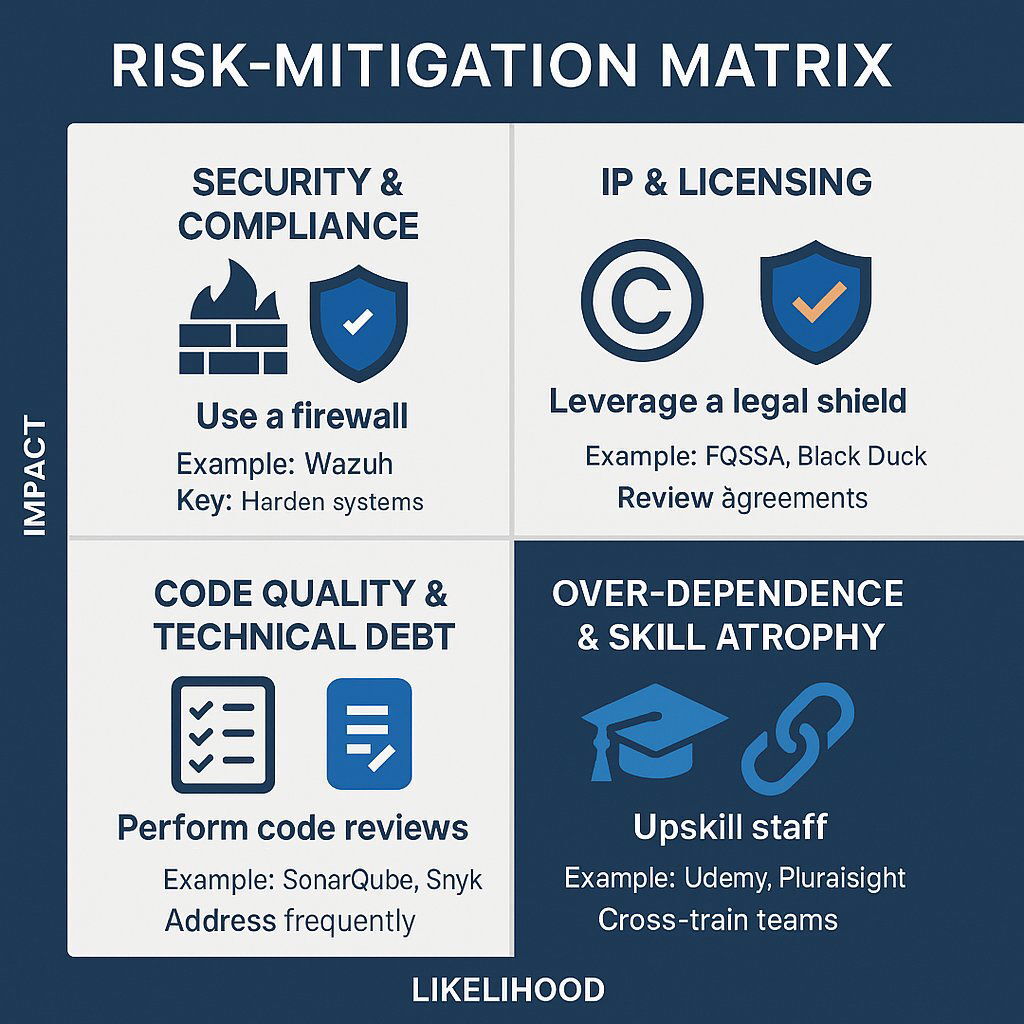
One new class of risk to note: probabilistic defects. Unlike classic software bugs, which are predictable and reproducible, AI-originated errors can be subtle and sporadic. Sometimes an AI-generated function works nine times out of ten, but that rare failure—rooted in a lack of training data or subtle context misunderstanding—can cause major disruption. This calls for a new QA philosophy, with robust shift-right testing and ongoing monitoring in production. For a deep technical dive on “non-deterministic” AI’s impact—and how to audit and govern it—review our comprehensive guide for C-suites.
Risk 1: Security & Compliance
Threat: AI can generate code with hidden vulnerabilities or even leak sensitive data into your codebase. Sometimes AI assistants suggest using out-of-date encryption or fail to validate inputs—potentially opening your systems to attack.
Mitigation: Layer a zero-trust mindset over your software engineering operations. Always treat AI-generated code as “untrusted” and pair with security scanning at the IDE and deployment pipeline level. Batch this with a DevSecOps culture for strong, iterative protection. Learn how executive-driven DevSecOps adoption is shaping next-generation secure development.
Risk 2: Intellectual Property (IP) and Licensing
Threat: Generative AI may suggest code sourced or inspired by protected intellectual property, sometimes even from GPL-licensed projects. This can open your business to unexpected legal risks—or even force unwanted open-sourcing.
Mitigation: Always use tools with origin tracing and license compliance checks. Integrating IP scanners within your CI/CD process and maintaining clear data governance policies can keep you on the right side of compliance.
Risk 3: Code Quality and Technical Debt
Threat: AI’s mandate is “good enough and fast”—sometimes at the cost of maintainability, efficiency, or clarity. Without proper oversight, your codebase can fill with black-box logic, hard-to-manage sprawl, or fragile modules.
Mitigation: Prioritize code reviews (not just for correctness, but for clarity and alignment to your standards), and use AI to check and optimize itself. See how forward-thinking organizations are evolving software maintenance and minimizing technical debt in our expert guide to post-launch success and maintenance.
Risk 4: Over-reliance and Skill Atrophy
Threat: Leaning too hard on AI can erode the skills of your engineering talent. If junior developers don’t build fundamental chops, your team may find itself thin on deep problem-solving expertise in a few years.
Mitigation: Position AI as a tool for growth, not replacement. Invest in training, structure code reviews around learning, and cultivate a culture of continuous improvement—so every developer is also a systems thinker, not just a prompt operator.
| Risk Category | Specific Threats | Baytech's Recommended Mitigation Strategy | Key Tools/Processes |
|---|---|---|---|
| Security & Compliance | Generation of code with vulnerabilities (e.g., injection flaws, weak encryption). Inadvertent exposure of sensitive data (e.g., API keys). | Implement a zero-trust approach to AI-generated code. Integrate continuous security analysis throughout the SDLC (DevSecOps). Mandate human review for all critical code sections. | Real-time security scanning in IDE (Snyk, DeepCode). Automated security gates in CI/CD pipelines. Mandatory human code reviews. |
| Intellectual Property (IP) & Licensing | Copyright infringement from training data. Introduction of code with restrictive open-source licenses (e.g., GPL), creating legal exposure. | Establish a clear governance framework for AI tool usage. Prioritize tools with IP indemnification and code referencing. Automate license scanning. | Enterprise AI tools with code origin tracking (Amazon CodeWhisperer). Automated IP and license compliance scanners in CI/CD. Formal data governance policies. |
| Code Quality & Technical Debt | Generation of inefficient, poorly architected, or undocumented code. Opaque logic makes future maintenance and debugging difficult. | Enforce rigorous human code reviews focused on architecture and maintainability. Align AI tools with organizational coding standards. Use AI to actively reduce existing technical debt. | Mandatory senior developer code reviews. AI static analysis tools for optimization (DeepCode). AI-powered documentation generation. |
| Over-reliance & Skill Atrophy | Decline in developers' fundamental problem-solving and critical thinking skills. Junior developers fail to learn core concepts. | Foster a culture of augmentation, not replacement. Implement dual-track training focusing on both AI tools and engineering fundamentals. Frame AI as a teaching and exploration tool. | Structured upskilling programs. Pair programming sessions (human-AI). Policies requiring developers to understand and explain all committed code. |
Section 5: The Baytech Playbook: A Strategic Framework for Executive-Led AI Adoption
Integrating AI into software isn’t just a question of technology—it’s an exercise in change management. Companies that win are those that reimagine workflows, invest in talent transformation, and reshape culture for long-term, cloud-native agile collaboration. The following playbook delivers a four-pillar strategy—practical, measurable, and led from the very top.
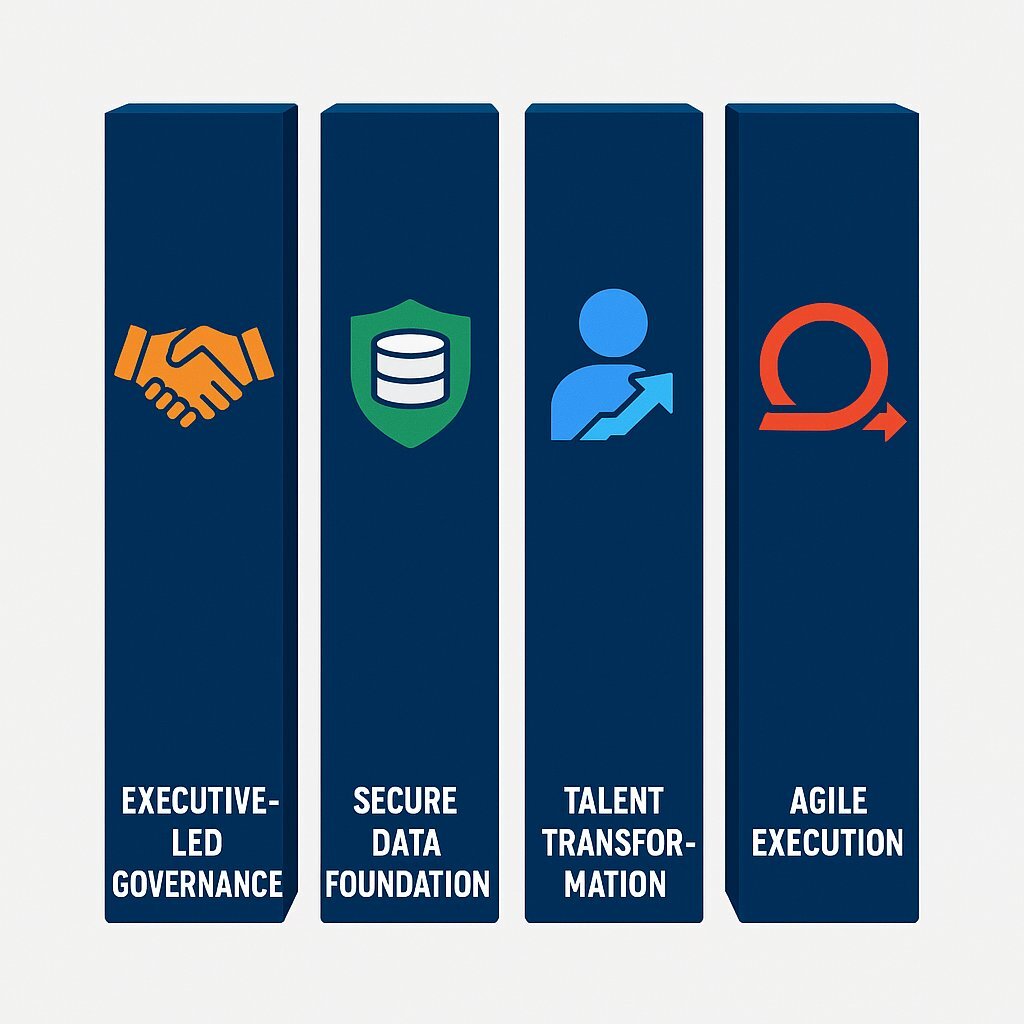
Pillar 1: Establish Executive-Led Governance
Treat AI as a top-down business strategy, not a grassroots experiment. Set clear objectives, appoint a leader, and structure your pilot projects for learning—not perfection. Put down guardrails up front—for compliance and responsible use—to banish shadow IT and make adoption safe and sustainable. For more on structuring successful pilots and managing digital transformation, see why the discovery phase is essential.
Pillar 2: Build a Secure, Data-Driven Foundation
High-caliber AI only works when your data is trustworthy and accessible. Make data governance central—no AI project should move forward without strong controls, unified architecture, and repeatable practices for data quality and privacy.
- Prioritize Data Governance: Don’t treat data as an afterthought. Set standards, establish policies, train your staff, and ensure visibility across departments for a single organizational “source of truth.”
- Break Down Data Silos: Cross-team and cross-system collaboration delivers richer, smarter models. Build infrastructure for unified, secure access—this is where your enterprise application architecture and business processes must work hand-in-hand.
Pillar 3: Transform Your Talent
AI should empower staff, not replace them. Invest in structured training, foster a culture focused on ongoing growth and experimentation, and develop higher-order skills—like system architecture, critical thinking, and code validation—that set your talent apart in the age of automation.
Pillar 4: Execute with an Iterative, Agile Mindset
Don’t expect a successful “big bang.” Launch small, learn fast, and adapt with each iteration—measuring not just lines of code, but impact on product quality, customer satisfaction, and key business outcomes. Flexibility, humility, and transparency win out over rigidity every time.
Conclusion: Building Your AI-Native Future, Today
Artificial Intelligence is truly redefining what it means to build and maintain software. The evidence shows that AI is not simply a trend, but a permanent shift toward smarter, faster, and more collaborative ways of working. The core question isn’t if you’ll use it, but how quickly you’ll make the leap—and whether your approach will secure a sustainable strategic edge.
Adopt a “co-creator” mindset: AI isn’t about simple automation, but about elevating human ingenuity. AI takes the drudgery out of software creation, letting your teams rise as architects and innovators. With a trusted strategy, robust DevOps foundation, strong governance, and partnership with a team like Baytech, your organization is ready not just to try AI, but to become truly AI-native.
The path forward isn’t without hurdles, but with clear vision, ongoing investment in your people, and agility at every level, you’ll build more than just great software—you’ll create a resilient, intelligent enterprise ready for whatever the future brings. Baytech Consulting stands ready to partner with you, from the first strategy session to large-scale transformation.
About Baytech
At Baytech Consulting, we specialize in guiding businesses through this process, helping you build scalable, efficient, and high-performing software that evolves with your needs. Our MVP first approach helps our clients minimize upfront costs and maximize ROI. Ready to take the next step in your software development journey? Contact us today to learn how we can help you achieve your goals with a phased development approach.
About the Author

Bryan Reynolds is an accomplished technology executive with more than 25 years of experience leading innovation in the software industry. As the CEO and founder of Baytech Consulting, he has built a reputation for delivering custom software solutions that help businesses streamline operations, enhance customer experiences, and drive growth.
Bryan’s expertise spans custom software development, cloud infrastructure, artificial intelligence, and strategic business consulting, making him a trusted advisor and thought leader across a wide range of industries.


